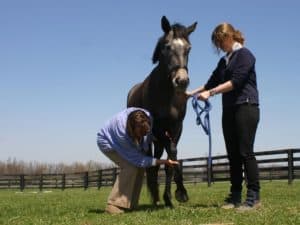Ultrasonography’s Role in Equine Lameness Cases

Ultrasonography has become one of the most versatile field imaging modalities for evaluating equine musculoskeletal injuries because it allows veterinarians to visualize almost any body tissue, most importantly soft tissues such as tendons and ligaments.
Ultrasound uses high-frequency sound waves to produce images in real time. The user holds a sound-wave-emitting probe against the skin toward the structure being evaluated. When the waves meet structures or interfaces between structures, they reflect back to the probe like a ship’s sonar. The more abrupt the interface or dense the structure, the more waves reflected. The more sound waves received, the brighter the structure looks on-screen. We describe brightness in terms of echogenicity. For example, bone appears bright (echogenic), normal fluid is dark (nonechogenic), and all other structures show up somewhere between.
With regard to lameness issues, your veterinarian is most likely to use ultrasound to assess tendons and ligaments, bone surfaces, synovial fluid, and cartilage. Think of tendons and ligaments as ropes made up of many strands or fibers. Tendons connect muscles to bones, while ligaments connect bones. When tendons or ligaments are strained, their fibers might tear. Veterinarians assess the extent of tendon or ligament damage by evaluating its size, echogenicity, and fiber pattern. Often, minor tendon or ligament injuries result in an increase in size, or cross-sectional area. In cases of significant disruption, veterinarians might notice changes in echogenicity and fiber pattern.
Normally, the “echotexture” or patterning of a tendon or ligament is homogenous (the same throughout); a perpendicular view of a normal tendon shows a round or ovoid structure with uniform shading. A damaged tendon might appear round and bright (normal fibers) with a dark area within it. Dark regions represent fiber disruption, or voids, where no sounds waves reflect. Larger, centrally located regions of fiber disruption are commonly referred to as core lesions.
Viewing this same region’s longitudinal axis, with the probe along the length of the tendon or ligament, the normally long, linear fibers might appear short and choppy or be missing altogether. Abnormalities are not always as overt, and true injuries could be as subtle as small, dark linear striations or mildly abnormal edges.
Ultrasound waves cannot penetrate bone, but veterinarians can use them to evaluate its surface. Due to bone’s density, it should look like a bright, white, smooth line on the screen. Bone surface changes at tendon or ligament insertion sites or around arthritic joints, fractures, or osteochondritis dissecans (OCD) lesions cause these lines to look disjointed and/or rough.
Evaluating characteristics within synovial structures (joints, tendon sheaths, and bursas) can be similarly useful. Normal structures have linings that produce a small amount of lubricating, nutrient-rich fluid. With inflammation from tendonitis, arthritis, direct trauma, or any other type of irritation, the lining produces excessive, poor-quality, and sometimes cell- and protein-rich fluid. Evaluating synovial fluid and lining can provide insight into inflammation severity. Additionally, veterinarians can examine joint cartilage for defects caused by traumatic injury or OCD.
Almost as important as making a diagnosis with ultrasound is treating and monitoring injuries with it. For tendon or ligament tears, for instance, veterinarians can administer regenerative products such as stem cells or platelet-rich plasma directly into the region of fiber disruption under ultrasound guidance. They insert a needle in the ultrasound beam so they can visualize penetration depth and see the therapeutic as it enters the space. Veterinarians can treat other areas, such as the sacroiliac, thoracolumbar and cervical facet joints of the spine, with anti-inflammatory agents via ultrasound guidance, without which they’d be doing it blindly and potentially too distant from the pain site to be effective. Ultrasound guidance also ensures the needle doesn’t inadvertently penetrate other structures.
After injury or treatment, veterinarians perform follow-up clinical and ultrasound exams to assess healing. They look for decreases in cross-sectional area, increases in echogenicity, and improvements in fiber alignment in tendon and ligament injuries. Ultrasonographic improvement and clinical improvement together guide recommendations to increase the horse’s workload.
The portability, versatility, and accuracy of today’s machines make ultrasound an incredibly useful tool. With it vets can image any tissue to determine diagnosis, while helping owners save money and time. It can also help guide placement of therapeutic agents and allow monitoring of recovery. If your practitioner suggests using ultrasound on your horse, knowing its uses, mechanics, and limitations can help provide clarity during the process.
Written by:
Matt Leshaw, DVM
Related Articles
Stay on top of the most recent Horse Health news with











